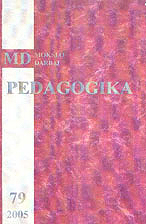Švietimo vertinimo raida Lietuvoje
Evolution of Evaluation of Education in Lithuania
Author(s): Rita Dukynaitė, Ričardas AlišauskasSubject(s): Education
Published by: Vytauto Didžiojo Universitetas
Keywords: evolution; education; Lithuania
Summary/Abstract: Quality of Education is one of the strategic goals in Lithuania as well, as in other European countries. For the quality assurance evaluation is crucial. It is necessary to understand phenomena of evaluation, to be aware of wide range of evaluation instruments, to understand trends in evolution of educational evaluation. Main goal of this article is to give a common picture of evolution of the educational evaluation in Lithuania. The two dimensional system was created to analyze the trends and range of instruments used in Lithuania. Dimension of time was split up into periods. For each period of time the name of educational strategy used in this period was given. Four periods were described in this way: period of the National school concept, period of the General Concept of Education in Lithuania, period of Priorities of the Second Stage of Educational Reform, and current Period of the State Strategy of Education. Instruments of evaluation were selected for the second dimension. Three groups of instruments were formed: evaluation of schools (process), national examination and students achievements studies (outputs), and systematic data analysis on the system level (policy). Assessment of students in the classroom was excluded from the system due to the conceptual distinguishing of education and teaching. Quality assurance on the school, region or country level is related to the evaluation of education. Student’s assessment done by teacher is related to the teaching level. On the basis of those two dimensions all main instruments of evaluation were registered into table. The table was the basis for analysis of trends of evolution of educational evaluation. It is possible to discover the fourth (current) period of this evolution as the most dynamic and progressive. More valid instruments are used in this period. The aims of evaluation are slightly changing. Evaluation is starting to be used not only for the compliance with regulation and quality control, but for finding strategic solutions for improvement, examples of best practice to be disseminated, and for more targeted supportive investments.
Journal: Pedagogika
- Issue Year: 2005
- Issue No: 79
- Page Range: 28-31
- Page Count: 5
- Language: Lithuanian

